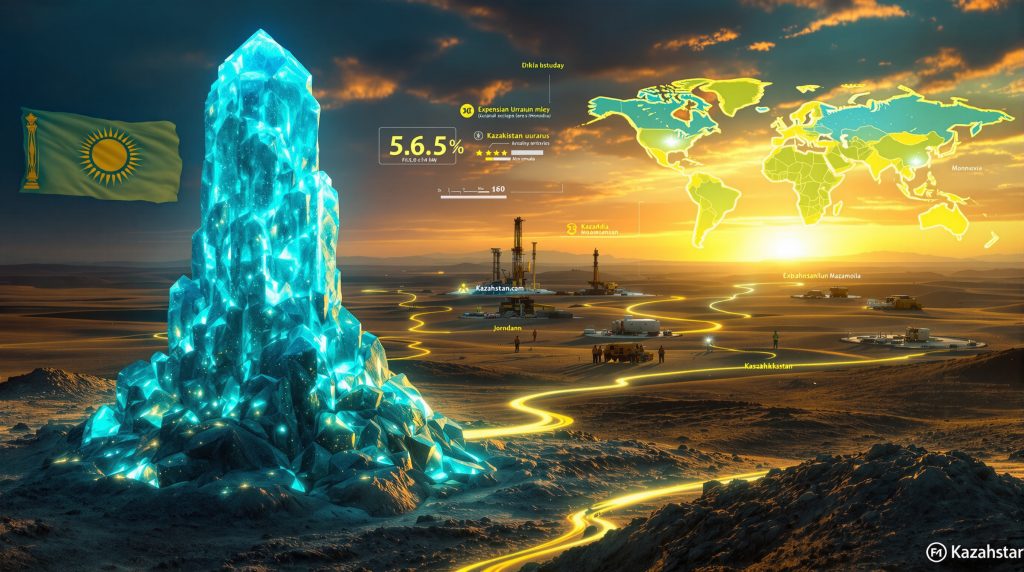How Is Kazatomprom Transforming Its Uranium Strategy?
Kazatomprom, the world's largest uranium producer, is implementing a dramatic shift in its operational approach by tripling exploration activities within Kazakhstan while simultaneously pursuing international ventures. This strategic pivot represents one of the most significant expansions in the company's history and signals a transformative change in global uranium supply dynamics.
Current Market Position and Production Capacity
Kazatomprom currently produces approximately 20% of the world's primary uranium supply, cementing its position as the dominant player in the global uranium market. The company has demonstrated strong performance in 2024, with a 13% increase in first-half production output compared to the previous year, according to official company statements at the World Nuclear Symposium in London.
The state-controlled mining giant has confirmed its 2025 production guidance, indicating confidence in its operational capabilities despite uranium market volatility. However, in a strategic move that reflects careful market assessment, Kazatomprom has announced plans to moderate expansion goals for 2026 due to prevailing market conditions.
Strategic Rationale Behind Exploration Increase
The ambitious tripling of exploration activities comes in direct response to projections from the World Nuclear Association that show uranium demand more than doubling by 2040. This anticipated surge in demand is driving Kazatomprom's proactive approach to resource development.
By dramatically scaling up exploration now, the company aims to secure long-term resource sustainability and maintain its market leadership position for decades to come. The expansion also represents a strategic move to diversify geopolitical risk through geographic expansion beyond Kazakhstan's borders.
Industry analysts note that this exploration surge demonstrates remarkable confidence in nuclear energy's future growth trajectory. The multi-decade planning horizon aligns with nuclear industry timeframes, where plant construction and operation cycles span 60+ years.
What International Ventures Is Kazatomprom Pursuing?
The company's international expansion represents a significant departure from its historically Kazakhstan-focused operations, creating new supply chain dynamics in the global uranium market.
Jordan Partnership Agreement
Kazatomprom recently signed a formal agreement for uranium asset development in Jordan, marking a milestone in its international expansion strategy. This partnership will leverage Kazatomprom's renowned mining expertise in new geological settings, potentially accessing Jordan's substantial uranium resources.
According to the Jordan Atomic Energy Commission, the country has identified uranium resources of approximately 65,000 tonnes in phosphate deposits and an additional 140,000 tonnes in other geological formations. This represents a significant opportunity for resource development.
The Jordan partnership is structured to create mutual economic benefits through knowledge transfer, with Kazatomprom bringing technical expertise while gaining access to new production areas. This collaboration model exemplifies the company's approach to international expansion.
Mongolia Collaboration Framework
In 2024, Kazatomprom established a cooperation agreement with Mon-Atom, Mongolia's state nuclear company. This partnership initiates early-stage exploration and resource assessment activities in a country with significant uranium potential.
Mongolia has estimated uranium resources of 62,000 tonnes, primarily located in the Dornod Province, according to International Atomic Energy Agency assessments. The geological characteristics of Mongolia's uranium deposits present both opportunities and challenges that differ from Kazakhstan's sedimentary formations.
This collaboration positions Kazatomprom strategically in an emerging uranium jurisdiction that could become increasingly important as global demand accelerates. The Mongolia partnership also demonstrates the company's ability to work effectively with other state-owned enterprises in the nuclear sector.
Additional Global Opportunities
Beyond Jordan and Mongolia, Kazatomprom is actively assessing further international expansion options. CEO Meirzhan Yussupov emphasized the company's strategic objective: "We are trying to diversify our operations on a global scale geographically."
This expansion focus prioritizes regions with established or promising uranium geology where Kazatomprom's technical expertise can be effectively deployed. The company is exploring potential joint ventures with established regional partners to accelerate development timelines.
This strategic diversification of the production portfolio beyond Central Asia represents a fundamental shift in Kazatomprom's business model and could reshape global uranium supply patterns in the coming decades.
Why Is Uranium Exploration Becoming Critical?
The global nuclear energy landscape is undergoing significant transformation, driving the need for expanded uranium exploration and production capacity worldwide.
World Nuclear Association Demand Forecast
The World Nuclear Association has issued a stark warning in its latest market report: uranium demand for reactors is projected to more than double by 2040. This forecast underscores the critical need for new mine development to meet future requirements.
Industry experts point to growing supply gap concerns as the primary driver of strategic investments in exploration. The long lead times for new uranium mines—typically 10-15 years from discovery to production—necessitate early and aggressive exploration programs to prevent future supply shortfalls.
The demand growth is being fueled by multiple factors, including extended operating licenses for existing reactors, new large-scale reactor construction programs (particularly in China and India), and the emergence of small modular reactor technologies.
Market Price Dynamics and Investment Climate
The uranium market has experienced remarkable price volatility in recent years. The spot price has more than doubled over the past five years to reach $76 per pound as of September 2025, reflecting strengthening market fundamentals and growing investor interest.
However, this represents a significant decline from the February 2024 peak of $106 per pound, which marked the highest uranium price since November 2007. This price volatility creates both opportunities and challenges for producers making long-term investment decisions.
The current price environment, while improved from historical lows, still requires careful assessment of project economics. Kazatomprom's balanced approach of increasing exploration while moderating near-term production expansion demonstrates sophisticated market awareness.
Nuclear Energy Renaissance Factors
A global nuclear renaissance is underway, driven by growing recognition of nuclear's essential role in decarbonization efforts. As of 2024, there are 58 nuclear reactors under construction globally, with China leading development with 21 units.
The development of small modular reactors (SMRs) is creating entirely new demand centers, with over 80 SMR designs currently in various stages of development worldwide. These smaller, scalable units could dramatically expand the geographic footprint of nuclear energy deployment.
Energy security concerns, particularly acute in Europe following recent geopolitical disruptions, are driving renewed interest in domestic nuclear capacity development. Many countries are recognizing nuclear power's role in providing reliable, baseload clean energy independent of fuel import challenges.
Additionally, long-term operation extensions for existing reactor fleets, particularly in the United States and Europe, are preserving uranium demand that might otherwise have declined as plants reached initial design lifespans.
How Is Kazatomprom Expanding Exploration in Kazakhstan?
The company's domestic exploration strategy represents a massive scaling of activities within its home territory of Kazakhstan, which holds approximately 12% of the world's known uranium resources.
Tripling of Exploration Capacity
"We have increased by triple our exploration capacities," stated CEO Meirzhan Yussupov at the World Nuclear Symposium, describing an unprecedented threefold increase in exploration resources and activities within Kazakhstan.
This expansion requires significant investment in drilling, geological surveys, and resource assessment capabilities. Industry experts estimate that such a dramatic scaling of exploration activities would require substantial capital commitment and technical resources.
The expansion includes enlargement of technical teams and expertise, with specialized geologists and mining engineers focusing on uranium resource development. Implementation of advanced exploration technologies and methodologies will accelerate discovery rates and improve resource characterization.
Strategic Focus Areas Within Kazakhstan
Kazakhstan's uranium wealth is concentrated in several sedimentary basins particularly suited to in-situ recovery mining methods. The exploration expansion will prioritize regions with established uranium potential while also venturing into previously under-explored territories.
A key focus will be the exploration of deeper deposits requiring advanced extraction techniques. These deeper resources may have been bypassed in earlier exploration campaigns due to technical limitations, but now represent important future supply sources.
The exploration strategy includes both brownfield exploration near existing operations and greenfield exploration in new areas. This balanced approach maximizes the potential for both near-term resource additions and long-term major discoveries.
Resource Security and National Economic Impact
The massive exploration expansion strengthens Kazakhstan's position as a global uranium leader and secures its economic interests in this strategic sector. The country produces approximately 45% of global uranium supply, making resource sustainability a national priority.
The expanded exploration program creates additional employment opportunities in technical and support roles throughout Kazakhstan's mining regions. It also contributes to developing domestic technical expertise and capabilities that enhance the country's human capital.
This initiative supports Kazakhstan's broader economic diversification objectives by reinforcing its position in the global nuclear fuel supply chain. The country aims to capture more value from its uranium resources through potential expansion into higher value-added nuclear fuel cycle activities.
What Production Adjustments Is Kazatomprom Making?
Despite the aggressive exploration strategy, the company is taking a measured approach to near-term production expansion, balancing market needs with sustainable growth.
2025 Production Guidance
Kazatomprom has confirmed its previously announced production targets for 2025, maintaining consistency in its market commitments. This stability provides important signals to uranium customers regarding supply reliability.
The company continues to focus on operational efficiency and cost management across its production portfolio. Technical innovations in in-situ recovery mining methods have helped optimize resource extraction while minimizing environmental impacts.
Kazatomprom's approach balances market supply with sustainable production levels, avoiding potential oversupply scenarios that could undermine price stability. This demonstrates sophisticated market awareness and responsible resource management.
2026 Production Moderation
In a significant strategic decision, Kazatomprom announced it would scale back previously planned expansion for 2026 in response to current market conditions. This responsive adjustment shows the company's willingness to adapt production plans to market realities.
The decision reflects a strategic production management approach aimed at supporting price stability rather than pursuing volume growth at the expense of market balance. This "value over volume" philosophy has become increasingly common among major uranium producers.
By moderating 2026 expansion plans while simultaneously increasing exploration, Kazatomprom is effectively investing in long-term capacity while exercising discipline in near-term supply growth. This balanced approach supports both market health and company sustainability.
Long-Term Production Strategy
Kazatomprom is building a robust resource pipeline through expanded exploration to support future production growth when market conditions warrant expansion. This creates strategic optionality to respond to changing market dynamics.
The company maintains production flexibility through its portfolio of operating assets and development projects at various stages. This allows responsive adjustment to market conditions without compromising long-term growth potential.
A key element of Kazatomprom's strategy involves balancing spot market opportunities with long-term contract commitments. The company has historically favored long-term contracts that provide revenue stability, while maintaining some production capacity for advantageous spot market sales.
The forward-looking exploration program enables Kazatomprom to develop production capacity ahead of projected demand increases, positioning it to capture market share when uranium demand accelerates in the 2030s.
How Does This Strategy Impact Global Uranium Supply?
Kazatomprom's exploration and expansion initiatives will have significant implications for the global uranium market and nuclear fuel supply chain that extend well beyond Kazakhstan's borders.
Market Share and Competitive Positioning
The aggressive exploration strategy reinforces Kazatomprom's position as the dominant primary uranium producer globally. With control of approximately 20% of current production, the company's strategic decisions have outsized market influence.
Depending on exploration success and subsequent development decisions, Kazatomprom could potentially increase its market share beyond current levels in the coming decades. This possibility will influence strategic planning by other major producers like Cameco, Orano, and emerging producers.
The company's strategic expansion gives it significant influence over global uranium pricing and supply dynamics. Market participants closely monitor Kazatomprom's production guidance for signals about future market balance.
Supply Security for Nuclear Utilities
Kazatomprom's exploration expansion enhances long-term supply visibility for reactor operators, providing confidence in fuel availability over the multi-decade operating horizons of nuclear plants. This supply confidence is critical for utilities making billion-dollar investment decisions on new reactors.
The potential for new long-term supply contracts backed by expanded resources creates options for utilities seeking to diversify fuel sourcing. Geographic diversification of supply through international ventures reduces concerns about concentration risk.
By developing multiple production centers through its international expansion, Kazatomprom is helping reduce the global nuclear industry's vulnerability to regional disruptions. This supply chain resilience is increasingly valued by utilities and energy security planners.
Impact on Uranium Price Trajectory
The balance Kazatomprom is striking between aggressive exploration and measured production growth could help moderate price volatility through improved supply predictability. The company's market-responsive approach to production planning sends stabilizing signals to market participants.
Long-term supply confidence provided by major exploration programs potentially offsets short-term price pressures by reassuring utilities about future availability. This balance is delicate, as perceptions of either shortage or oversupply can drive significant price movements.
Kazatomprom's strategic moves are creating market signals that encourage investment across the uranium sector. The company's confidence in future demand growth validates similar assessments by junior mining companies and exploration ventures.
What Challenges Does Kazatomprom Face in This Expansion?
Despite the strategic benefits, Kazatomprom's ambitious exploration and international expansion plans face several significant challenges that will require careful management.
Geopolitical and Regulatory Considerations
Managing political relationships across diverse jurisdictions presents complex challenges for a state-controlled company with global ambitions. Kazatomprom must navigate different political systems and national interests in each target country.
The company faces varying regulatory frameworks for uranium development in new territories. Countries like Jordan and Mongolia have different environmental regulations, permitting processes, and stakeholder engagement requirements than Kazakhstan.
Uranium is considered a strategic resource in most countries, creating additional regulatory scrutiny and potential limitations on foreign control. As a state-owned enterprise, Kazatomprom may face particular scrutiny regarding its ownership structure and government connections.
The company must balance commercial objectives with diplomatic sensitivities, particularly when operating in regions with complex geopolitical relationships. This requires sophisticated government relations capabilities alongside technical mining expertise.
Technical and Operational Challenges
Adapting mining techniques to different geological conditions represents a significant technical challenge. Kazakhstan's expertise is heavily concentrated in in-situ recovery mining of sedimentary deposits, while international targets may require different extraction methods.
Scaling technical expertise across expanded operations will require significant human resource development and knowledge transfer programs. The company will need to develop expertise in new mining methods while maintaining operational excellence in existing operations.
Managing environmental impacts across diverse ecosystems requires specialized knowledge of local conditions and regulatory requirements. Different countries have varying standards for environmental protection, particularly regarding water resources crucial for in-situ recovery operations.
Ensuring consistent production quality from new resources is essential for maintaining Kazatomprom's reputation for reliability. Technical challenges in processing uranium from different geological formations could affect product specifications and customer acceptance.
Market and Financial Constraints
Balancing exploration investment with shareholder returns presents a classic mining industry dilemma. Exploration represents long-term value creation but requires significant upfront capital with uncertain returns.
The company must carefully manage capital allocation across competing priorities, including maintenance of existing operations, development of new projects, and returns to shareholders. This balance is particularly important for state-owned enterprises with public accountability requirements.
Market participants may express concerns about potential oversupply if exploration success leads to accelerated production growth. Kazatomprom must carefully message its long-term production intentions to avoid undermining market confidence.
Maintaining financial discipline during aggressive expansion requires sophisticated capital planning and project evaluation. The company must establish clear economic thresholds for advancing projects from exploration to development phases.
What Does This Mean for the Future of Nuclear Fuel Supply?
Kazatomprom's strategy represents a significant vote of confidence in the long-term prospects for nuclear energy and uranium demand, with implications that extend throughout the nuclear fuel cycle.
Nuclear Renaissance Support
The exploration expansion aligns perfectly with projected nuclear capacity growth worldwide. As of 2024, there are 58 nuclear reactors under construction globally, with hundreds more in planning or proposal stages.
By investing in future supply capacity, Kazatomprom provides supply confidence for utilities considering new reactor investments. This confidence is particularly important given the 60+ year operating lifespans of new nuclear plants, which require assured fuel availability throughout their operation.
The strategy supports the case for nuclear as a reliable baseload clean energy source by addressing potential concerns about fuel sustainability. Supply security is a critical component of nuclear's value proposition as a stable, low-carbon energy source.
Kazatomprom's market actions demonstrate industry confidence in long-term demand fundamentals, providing important market signals that can influence investment decisions throughout the nuclear supply chain.
Supply Chain Resilience
Geographic diversification through international ventures enhances overall supply chain security for the global nuclear industry. Reducing concentration risk in Central Asia benefits both producers and consumers of uranium.
Developing multiple production centers reduces vulnerability to regional disruptions, whether from political instability, regulatory changes, or natural disasters. This distributed production model enhances overall system resilience.
The expanded resource base provides a buffer against unexpected demand increases, such as those that might occur with accelerated nuclear development due to climate policy changes. This supply flexibility supports energy transition planning that includes nuclear expansion.
Kazatomprom's long-term planning horizon aligns with nuclear industry timeframes, where fuel security considerations extend decades into the future. This temporal alignment strengthens the overall stability of the nuclear fuel ecosystem.
Sustainable Development Considerations
Kazatomprom's expansion creates opportunities to implement best environmental practices across new operations. The company can apply lessons learned from Kazakhstan to establish industry-leading standards in new jurisdictions.
Advanced environmental management techniques, particularly for water conservation in in-situ recovery operations, can be deployed in international ventures. These techniques minimize environmental footprints while maximizing resource recovery.
The strategy supports the clean energy transition through nuclear fuel security. By ensuring uranium availability, Kazatomprom enables broader deployment of nuclear energy as a low-carbon electricity source.
Balancing resource development with environmental stewardship will be essential for maintaining social license to operate across diverse communities. Responsible uranium development requires careful attention to environmental impacts, worker safety, and community benefits.
FAQ: Kazatomprom's Exploration Strategy
How much of the world's uranium does Kazatomprom currently produce?
Kazatomprom currently produces approximately 20% of the world's primary uranium, making it the largest single producer globally. Kazakhstan as a country produces about 45% of global uranium supply, with Kazatomprom responsible for the majority of this output.
What factors are driving Kazatomprom's decision to triple exploration?
The decision is driven by projections showing uranium demand more than doubling by 2040, as forecast by the World Nuclear Association. Additional factors include the need to secure long-term resources to maintain market leadership, the strategic goal of geographic diversification, and the long lead times required to develop new uranium mines from discovery to production.
Which countries has Kazatomprom targeted for international expansion?
Kazatomprom has recently signed an agreement with Jordan for uranium asset development and established a cooperation framework with Mongolia's state nuclear company, Mon-Atom. The company has indicated it is assessing additional international opportunities but has not publicly disclosed specific target countries beyond these two initial partnerships.
How have uranium prices performed in recent years?
Uranium spot prices have more than doubled over the past five years to approximately $76 per pound as of September 2025. However, prices have declined from a peak of $106 per pound reached in February 2024, which was the highest level since November 2007. This volatility reflects changing market perceptions about supply-demand balance and growing investor interest in uranium as a strategic commodity.
Is Kazatomprom increasing current production along with exploration?
While Kazatomprom has confirmed its 2025 production guidance and reported a 13% increase in first-half 2025 output, the company has indicated it will scale back previously planned production expansion for 2026 in response to market conditions. This demonstrates a measured approach that balances near-term market conditions with long-term resource development through exploration.
How long does it typically take to develop a new uranium mine?
The development timeline for uranium mines typically ranges from 10-15 years from initial discovery to commercial production. This extended timeline includes exploration, resource definition, feasibility studies, permitting, construction, and commissioning phases. The lengthy development process is one reason why Kazatomprom is accelerating exploration now to meet demand projected for the 2030s and 2040s.
What mining methods does Kazatomprom typically use?
Kazatomprom specializes in in-situ recovery (ISR) mining, which involves injecting a leaching solution into permeable uranium-bearing sandstone to dissolve the uranium. This solution is then pumped to the surface for processing. ISR is generally considered more environmentally friendly than conventional open-pit or underground mining as it causes minimal surface disturbance and does not produce tailings or waste rock.
How might Kazatomprom's strategy affect other uranium producers?
Kazatomprom's exploration expansion and international ventures will likely influence strategic planning by other major producers like Cameco and Orano, potentially accelerating their own resource development efforts. Junior mining companies may find opportunities for partnerships or acquisitions as interest in the sector grows. However, concerns about potential future oversupply could impact investment decisions and project financing across the industry.
Want to Know When the Next Major Uranium Discovery Happens?
Don't miss the next major uranium investment opportunity! Discovery Alert's proprietary Discovery IQ model provides instant notifications when significant ASX uranium discoveries are announced, giving you a critical market advantage. Explore why historic discoveries generate substantial returns by visiting our dedicated discoveries page.




